Blake Bell's Blog, page 3
June 20, 2013
A Life Well Lived: Memories of Kim Thompson

I think that you’ve lived a life worth living if you:
Lived and died doing what you loved for a living;Left the world a better place because of your contributions;Made a tangible impact on at least one person who is better off for knowing you;Have people praise you when you are alive, as well as when you are no longer with us.
There are plenty of other people who knew Kim Thompson better and for longer, who worked closer with and lived closer to him, but I think I knew well enough and worked with him long enough to say with good certainty that Kim nailed it on all four of the above points.
For those unaware, Kim Thompson is the co-publisher of Fantagraphics Books Inc., alongside his friend and business partner of 35+ years, Gary Groth. Kim passed away Wednesday, after a short battle with cancer, and I count myself blessed to have worked with both men, almost exclusively with Kim for the past two-and-a-half years on what will total nine books by the end of 2013 with their company.
The first thought that comes to mind when I think, “Kim Thompson!” is that the man was blessed to have spent his entire professional life doing what he loved – working in the comic-book field, producing a ton of quality comic books and graphic novels (including a number of translations, and “foreign” artists that may never have seen North American shores without Kim’s efforts).
Like, he got to do it full-time. For a living. That’s frickin’ cool.
I met Kim for the first time at the San Diego Comic-Con in 2001. More on that a little later, but I remember sitting there at the Eisner Awards that year, just dreaming about one day being able to be a working part of the industry, enthralled by the love of the medium that was present in that room.
You may have gleaned this, but (other than living off of the usurped intellectual property of a few of the founding fathers in comics) making a living in comics ain’t easy and can be downright perilous. It’s, to date, a print medium featuring non-moving (in literal/comparative terms to movies and video games) imagery. That’s a major strike against you in the 21st century. I have a 13-year old son who loves the superhero movies and video games, but barely touches a comic book. Most people in the comic-book industry probably feel either like King Sisyphus (expending all that energy rolling that rock up the hill, always worried that it might roll down again at your first sign of weakness) or Moses, who didn’t make it into the promised land because he tapped a rock instead of shouting at it. It can feel like that thin of a razor’s edge. And you don’t dare divide the number of hours worked into the compensation. The thought of such an hourly rate would drop you dead from a heart attack on the spot.
I belabour this point only to make the point that you are only able to survive in this industry if you absolutely love what you are doing. And there’s little doubt Kim did.
Kim and Gary chose a path of quality product over fat profit margins, and were leaders in standing for what they believed was right in an industry with a history of publishers who used and abused those who made them millions with their creations.
Choosing that path meant, on many books, no doubt, slim to little profit margins, but they always aimed for the highest quality in everything they published, pushing the limits of production, spending the extra money to make the physical product that much more special. A number of my books have numerous little “flourishes” that a publisher more invested in their bottom line wouldn’t have bothered with. They, however, took immense pride in seeing the realization of their efforts; that moment when they finally held the book in their hands and would show me what they had done.
That’s a lot of “we” and “they” for a piece on Kim’s passing, but (for me, at least) tough to separate the two men. They did, indeed, have some similar personality traits – at times, like mischievous kids in Junior High – but you could easily discern that they also were opposites in a number of areas, but were blessed that those complimented each other perfectly, and their business, perfectly.
As mentioned, my first encounter with Kim was at the San Diego Comic-Con in 2001. It was my first convention outside of my home country of Canada, and it was an eye-opener for many reasons. Not just because of its scope, but because all my heroes of the Silver Age of Marvel Comics were there (for one of the last times), and because my first-ever article on comics was published by TwoMorrows in an issue of Comic Book Artist.
Somehow, this led to a meeting with the pre-Kim Thompson other half of Fantagraphics, Mike Catron (now happily – for me – back at Fantagraphics and editing my work). He was filming seemingly every panel at that SDCC. And somehow he looped me into helping man his camera so he could film more panels.
One panel that I ended up filming was a (I want to say 25-year look back at the history of) Fantagraphics panel with Gary, Kim and Mike on the dais.
Mike pretty much introduced me to the entire comic-book industry at that Con. Back then, other than that first article, I had made a few contributions to Alter Ego, but was mostly known for a Steve Ditko site I had started in 1998 that led to, that summer of 2001, being the web-designer/master for Steve Ditko and his co-publisher’s internet site for their self-publishing efforts (a site that lasted until they read that first article o’ mine in early September).
As Mike was introducing me to Kim and others, that designation of mine caught the ear of Gary Groth, who turned his eye to me and 12 years-to-date of association was born.
Most of my original interaction was with Gary, but once my first Ditko book began to really come together in 2007, I was blessed to work with both, either together, or (since 2010) almost exclusively with Kim editing and shepherding my Ditko and Everett books into existence.
Kim left numerous impressions on me. First, he had a wonderful balance of Gentleman and fiery pursuer of quality at the expense of your ego. That’s not easy to accomplish.
What I mean by that is he clearly loved his craft so much that his genuine goodness as a person helped him get the best out of people like myself – almost nurturing in a fashion – but could also be tough if you crossed a line, in terms of the quality of your work, or if you exhibited a lack of diligence in living up to your obligations in producing it.
Kim and Gary aren’t arrested adolescents; they are professionals who put their living on the line every day. It’s a difficult industry to rise above an earnings threshold, and quality work and ambitious respecters of the process are table stake expectations. You may not be Joyce, Wilde, or Wolfe, but you’re not going to take them down with you below a certain level of quality that they have set the bar at achieving on all projects.
Kim had that balance down pat, demanding a good job, but also able to be an understanding person when life has its ups and downs that, especially in an industry where many can’t make it as their sole livelihood, can impact the work you do.
He hit me hard on my very first book, I Have To Live With This Guy!, from back in 2002 (deservedly so), and I lived with it through to my 2008 book for Fantagraphics – Strange and Stranger: The World Of Steve Ditko – and beyond. I was determined to show him growth in my writing with each new project, and that I could produce. Publishers love producers, especially ones that don’t give them a lot of grief. And he was kind enough to acknowledge that each project got better. I was just re-reading an email exchange tonight, from June of 2010, regarding the introduction to the second volume of the Steve Ditko Archives. He had flipped me his edit, and I virtually begged him for commentary on its quality. He said:
“Worked for me, some good insights. Solid. Not too hard to work on, your effort definitely showed.
Zoom zoom,
--k.t.”
That was a big accomplishment in my book, as was the copy for the distributor catalog for one of the Ditko Archives (in 2011) where he said he barely had to change a thing.
Back in 2008 and 2010, I thought I was the BMOC when both Gary and Kim proofed my first Ditko book and then my first Bill Everett book, the latter exchange done whilst on my honeymoon, a two-week cruise of the Caribbean. Gary went first and when he was done, I told my new bride, “Ok, Kim’s going to go over, but probably just a few extra things.” Wrong. Kim was that good of a proof-reader and editor.
After that exchange, I really doubled-down on producing quality work because I knew what was expected from Kim. In November of 2010, he took over the “Blake Bell franchise”, as he called it, because Gary was tipping the scales a bit more at that time, and we worked exclusively together on all my books since.
I’m jumping all over the place now – how Kim would not approve – but many more memories are coming back that represent the man even as I write. Amongst them:
It became a running joke that he chose all the titles of my books from Strange and Stranger and Fire and Water, to all the Ditko and Everett Archives. (For those, I’d give him a bunch to choose from, but he’d then pick ‘em. Why mess with success?) I only hold the belt for coming up with The Secret History of Marvel Comics.
He was quick to embrace an idea he loved, even if it cost him more time than he budgeted for. I came up with this crazy idea for the first Steve Ditko Archives of having the “Fanta Generation” of “alternative cartoonists” write essays on those pre-Code Ditko stories and we’d intersperse them through the book. Seth, Dan Clowes, Gilbert Hernandez, Dash Shaw, etc. , even Frank Miller. And he diligently went after every one of them. We let it go when we couldn’t get enough to sign up in the timelines we needed them by, but I appreciated his tolerance!
The man also took care of me. In other words, he made sure I got paid on time. That’s a big deal in this industry, especially for someone of my “stature.” (I.e., I’m not exactly going to “take down” Fantagraphics with me if I stopped producing books about comic-book creators born before the Great Depression.) And, over the past three or so years, I’ve really needed to get paid on time, and he was always able to deliver and understand the whys, and sharing a sympathetic note amongst his insanely busy schedule.
He'd forward me emails from comic-book creators who had nice things to say about my books, and he sent me the email telling me about my first Eisner nomination for my Fire and Water Bill Everett book. That took me right back to that 2001 SDCC on Eisner Awards night, thinking about how I’d like to be Jill Thompson, running up to that stage with such incredible enthusiasm. It wasn’t the award/nomination that was of interest; it was being part of a “family” and I am thankful to Kim (and Gary) for allowing me to be a part of theirs.
That’s what made that email from March of this year so shocking. It was the note that he had cancer. We followed up with an exchange about how he was going to beat this, and I still remember that feeling when I saw that update, the one where it dawned on me for the first time that he wasn’t going to conquer this. My step-father passed away even quicker from cancer back in 2000, so it shouldn’t be a shock, but a world without a vital Kim Thompson producing comic books and graphic novels still seems like a world that has been knocked off its axis. The world will right itself, but will feel just different enough.
So, he lived his whole life doing what he loved to do; he left the world a better place because of all the fantastic books he brought to all of us; he made a tangible impact on me as a writer and editor; and I am one of those people who praised him while he was with us and am praising him now as a professional and as a man.
A life well lived.
Published on June 20, 2013 20:12
May 18, 2013
Steve Ditko Archives goes Digital: More on "Strange Suspense"
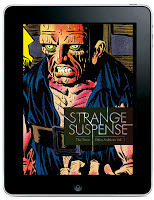 Last Saturday, we posted the news that you can now order a digital version of my book, Strange Suspense: The Steve Ditko Archives vol. 1 via Comixology. This has jump-started us to take a deeper look at some stats from the original art that differ quite a bit from the published version of the story found in the volume. First, we looked at "Range War", and now we take a look at the stats of Ditko's 3rd professional solo job, "A Hole In His Head." The 6-page story is from 1953's Black Magic #27, done when Ditko briefly worked at the Joe Simon & Jack Kirby studio.
Last Saturday, we posted the news that you can now order a digital version of my book, Strange Suspense: The Steve Ditko Archives vol. 1 via Comixology. This has jump-started us to take a deeper look at some stats from the original art that differ quite a bit from the published version of the story found in the volume. First, we looked at "Range War", and now we take a look at the stats of Ditko's 3rd professional solo job, "A Hole In His Head." The 6-page story is from 1953's Black Magic #27, done when Ditko briefly worked at the Joe Simon & Jack Kirby studio.Really, this post and my last were inspired by Nick Caputo's examination of the two stories in question. Here's a link to his "Jack Kirby, Steve Ditko and that old Black Magic" post that looks at the latter story for alterations to Ditko's artwork by Kirby.
The B&W stats show some different alterations to the production work on the first page but, most importantly, to the last panel of the story that was wiped out and replaced with an pimple ointment ad! Before that, though...
Still want a print copy?
I still have a few copies of the $39.99 hardcover of Strange Suspense: The Steve Ditko Archives vol. 1. If you'd still like a paper version, send me an email at ditko37@rogers.com. I am only asking for the cover price plus any shipping and handling costs to your location. (Correct, I'll charge you just exactly what it costs to bring it to your door, and no more.)
"A Hole In My Head"
Okay, Black Magic #27. Below is the published splash panel of the first page.
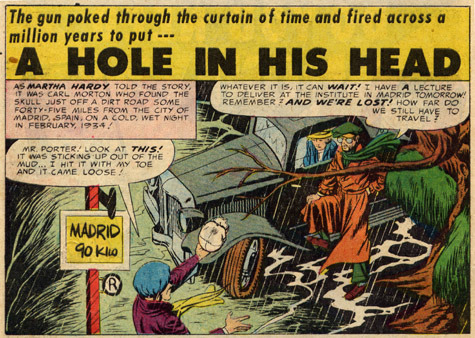

It's unrealistic to think that there wasn't a story title before the whole story was put together, but it looks like it was a paste-up added later, doesn't it? It's tough to make out those letters near the top on the right. Looks like "ANE -- BU7". (Anyone have a suggestion?)
Notice also the signpost! "Madrid 90 kilo" is missing on the B&W stat. It's not like Madrid wasn't already identified as the destination in the text right in that first panel. And in the 2nd panel (not seen here), they mention the 90 kilos on the signpost.
But the most fun comes from the last page of the story. Spoilers: These three characters find a skull with a hole in its seemingly-neanderthal head. They then get into a fight over the woman, fall into a pit, which takes them back into time where one of the men shoot the neanderthal in the head, and they all go crazy realizing the paradox. Only the woman escapes with her life, leading to the last two panels in the story...except that in the printed version, there is no last panel...
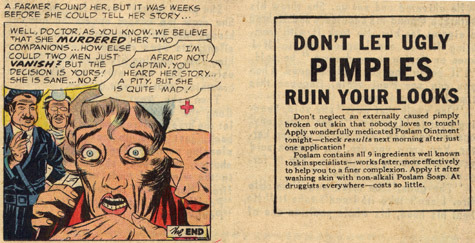
...there's just the oddity of that pimple ointment panel. But, okay, there's a "The End" box in that first panel, so it must have been the end of the story, right? Not so fast. Here's the B&W stat of the same...
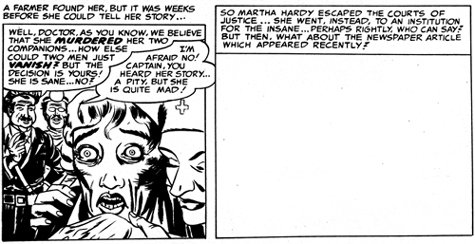
Now, as Nick Caputo says in his blog post, Ditko did these early Black Magic stories for the Joe Simon and Jack Kirby studio. Those two packaged comics for other publishers, so they'd go over each story from the artists who did work for the studio and, if they didn't think something would help sell the comic, they'd make changes in story and art.
It's probably safe to say that the writer of this story had the last panel with a newspaper article and Ditko and/or Ben Oda, the letterer tried to reproduce the look of a newspaper. Clearly, though, Simon or Kirby didn't like it enough; enough to wipe out the whole panel! But don't you want to know that article said? Perhaps the skull was found, but buried in a little story that no one noticed?
Clearly, Simon/Kirby thought the presentation of the last panel was so weak that they were willing to toss the "twist ending" and just leave it at the woman as having gone insane. (Wonder how much money they made, if any, off of the placement of that pimple ad? Probably seemed like a good trade at the time. They most definitely didn't think some Canadian and a New Yorker would be examining this stuff 60 years later!)
Lots of mysteries and stories can be found in the digital/print version of Strange Suspense: The Steve Ditko Archives vol. 1. Get yours today.
We'll be back soon with news on Heroic Comics: The Bill Everett Archives vol. 2! God bless you all. (John 15:12-17)
Published on May 18, 2013 10:14
May 11, 2013
Steve Ditko Archives goes Digital via Comixology
 It's been a long time since we've posted here, and that's because I've been working: A) through the final stages of production on my three books that will come out in the second half of this year; B) planning the next two (yep, more on this soon); C) watching translations come to life for a couple of my older books; and D) seeing my back catalogue venture into the digital realm.
It's been a long time since we've posted here, and that's because I've been working: A) through the final stages of production on my three books that will come out in the second half of this year; B) planning the next two (yep, more on this soon); C) watching translations come to life for a couple of my older books; and D) seeing my back catalogue venture into the digital realm.The first of two on the e-docket now (more on number two coming soon) is the most appropriate. Volume one of my Steve Ditko Archives, Strange Suspense, has been sold out from Fantagraphics and Amazon, etc. (plus I never see it pop up on e-Bay) for quite a while now.
But Fantagraphics and Comixology (the leader in comics on the digital platform) have delivered on a digital version! 238 pages of pre-Comics Code Authority Steve Ditko horror comics (plus a Western and Romance story!)
Download Strange Suspense: The Steve Ditko Archives Vol. 1 here from Comixology.
Still want a print copy?
Yes, I still have a "stash" of about 10 copies of the $39.99 hardcover. If you'd still like a paper version, send me an email at ditko37@rogers.com. I am only asking for the cover price plus any shipping and handling costs to your location. (Correct, I'll charge you just exactly what it costs to bring it to your door, and no more.)
I'll spend the next 9 days updating everyone on each of my current projects, which include Heroic Tales: The Bill Everett Archives vol. 2, The Secret History Of Marvel Comics, and Impossible Tales: The Steve Ditko Archives vol. 4, and we'll see what I can reveal about the yet-to-be-revealed ones! Now, let's take a deeper look at some of the quirks of Ditko's earliest work that is included in Strange Suspense: The Steve Ditko Archives vol. 1...
Steve Ditko Minutiae
One of the great authorities today on Steve Ditko and the Silver Age of Marvel Comics is Nick Caputo. Nick was actually "in the house" when the very first copies of my Strange And Stranger: The World of Steve Ditko were unboxed into our hands (delivered to the MoCCA museum for the same-named festival back in June of 2008).
He's written for publications like Alter Ego, Jack Kirby Collector, Comic Book Artist, Comic Book Marketplace, Jack Kirby Quarterly, Ditkomania and Marvel's Omnibus and Masterworks collections. This past week, he's published two entries on his Marvel Mysteries and Comics Minutiae blog that talk directly to the contents in volume one of my Steve Ditko Archives series. Here's the first:
Early Ditko and the mystery of the Utah Kid
Remember that Western story I mentioned above? It's one of the first jobs that Ditko ever drew: Blazing Western #1 (Jan '54). You can read those details on Nick's blog, but that Utah Kid mystery of which he speaks triggered something in my memory, so I ran to my files and found the black-and-white stats of the story (how rare is that?) and solved said mystery.
The genesis of Nick's post is that one can tell in the word balloons that another name for the character was erased and the Utah Kid was placed in its stead. Here's the published version from the original comic (buy the digital version and see how well Fantagraphics cleans up the source material for the Steve Ditko Archives series!) beside the original B&W version (followed by the splash page panel containing the balloon - click on all the images to see larger versions)...
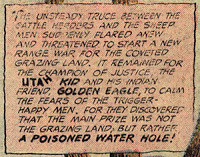

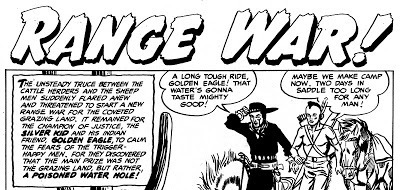
So, the mystery of the Utah Kid is that he was originally the Silver Kid. Even more intriguing, though, is that, nine months later, a Silver Kid character appears in Silver Kid Western #1 from Key Publications. As Nick says in his blog post, "'Range War' was an eight page story published by Timor publications, one of a group of imprints, including Stanmor, Gilmore and others, under publisher Stanley P. Morse...Some of Ditko's earliest sales were to Morse, including 'Paper Romance' in Daring Love # 1 (Sept-Oct 1953), with others sold to Ajax-Farrell. Some stories may have been produced for other companies, but eventually saw publication through Morse." And who owned Key Publications? Stanley Morse, of course.
What's also interesting is that, in the published version of "Range War", they blacked out the white streak of hair from the original that would later be the "trademark" of the Silver Kid character in the Key Publications' book...

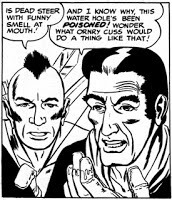
There's no obvious reason why the Silver Kid was changed into the Utah Kid, and then brought back in his own comic. Was Morse planning a Silver Kid comic, didn't like the story (but liked the character and the name "Silver Kid"), and dumped it into one of his Western genre books? Or the Silver Kid book was delayed for some reason (or abandoned, at least for 9 months) and Morse wanted a return on a story that he had paid for? (The eventual Silver Kid comic had a different name and look for the sidekick, so changes were made for the "long-awaited" debut).
We'll be back Monday to look at the alterations that Nick mentions in his next post from Black Magic #27, and then we'll get to my projects' updates. God bless, everyone (John 3:16).
Published on May 11, 2013 10:46
February 4, 2013
Finder's Fee for Bill Everett Archives Help!
 That's right - if you can help us find someone with a copy (someone who possesses the original comic book) of
Target Comics v1 #8
and
Silver Streak Comics #1
, we will give you a copy of Heroic Comics: The Bill Everett Archives v2 (pictured left) and Amazing Mysteries: The Bill Everett Archives v1. (Click HERE to email me.)
That's right - if you can help us find someone with a copy (someone who possesses the original comic book) of
Target Comics v1 #8
and
Silver Streak Comics #1
, we will give you a copy of Heroic Comics: The Bill Everett Archives v2 (pictured left) and Amazing Mysteries: The Bill Everett Archives v1. (Click HERE to email me.)These are the last two items we need to complete the Bill Everett Archives v2. Target #8 contains a 6-page "Chameleon" story by Bill. Silver Streak #1 contains a text story with its first page having two illustrations by Bill. If we get these two, we'll have documented all of Bill's Golden Age work (quite an achievement, given the rarity of this 1938-42 material).
Target #8 is a challenge because it contains a Basil Wolverton Spacehawk story. Silver Streak #1 is also tough because of its 1939 date (and the Alan Cross and subsequent reprints left out the text story). I fear that the practice of "slabbing" books has likely led to a number of these key Golden Age books being encased in plastic for all time, hence the challenges we're having in locating them.
That's why we're offering a finder's fee. Of course, the person who owns the comics will get comp. copies of the Archives series, but if you find that person, we'll comp you, and put your name in the latest book too.
Volume two is going to be the last in the Bill Everett Archives series, so it would be a real shame to not have that work of his documented. Please pass a link to this message amongst your peers and retailers.
Published on February 04, 2013 09:13
December 8, 2012
Bill Everett 1950 Lev Gleason story unearthed
 Some of the most satisfying moments in putting together the Bill Everett Archives volumes have been discovering hitherto unknown works that seemingly no one knew existed, and that fall outside of Bill's normal modus operandi - i.e., working as a virtual lifer for Marvel Comics, creating the Sub-Mariner in 1939, doing all those horror books in the 1950s, and co-creating Daredevil in the 1960s.
Some of the most satisfying moments in putting together the Bill Everett Archives volumes have been discovering hitherto unknown works that seemingly no one knew existed, and that fall outside of Bill's normal modus operandi - i.e., working as a virtual lifer for Marvel Comics, creating the Sub-Mariner in 1939, doing all those horror books in the 1950s, and co-creating Daredevil in the 1960s.We're still one story away - Target Comics #8 - from completing Everett's 1938-42 work in volume 2. If you have this comic, please email me.
Amazing Mysteries: The Bill Everett Archives v1 focused on Bill's earliest Golden Age comics - from 1938 to 1942 - for companies other than the oft-reprinted Marvel superhero work. Heroic Comics: The Bill Everett Archives v2 completes that material and then moves into some of his most stunning work. And it's been this pursuit - especially the 1950s canon - that has led to some fantastic surprises.
The most recent is a story in Crime and Punishment for the company, Lev Gleason, (in)famous for its Crime Does Not Pay title and other books that brought the crime genre into comics. Collectors and historians have assumed that when Everett came back from WWII he jumped right into the Sub-Mariner books and then into the horror work. In fact, circa 1949-50, just after the Marvel heroes died off in 1949, and before the horror genre overtook that company, Everett did reach out to some other publishers to either fill a gap or load up on income, given that he would be bringing three children into the world around these years.
Everett wrote the following in a 1961 letter to comic fan, Jerry Defuccio: "Things got rough about 1949, and I felt it advisable to pack up and move back to New York. I left my family (two kids by now) in Erie, Pa., with my sister and her family, and came to N.Y. by myself. I picked up comic accounts with Quality Comics, Eastern Color, and, of course, with Stan Lee. Things finally started to good in '50, and my family joined me (four of us lived and worked - in one tiny room in a mid-town hotel for six months!), and we eventually moved to Ridgewood, New Jersey, where I brought a small house."
Everett reestablished his connection with Steve Douglas, editor at Eastern Color, and did a number of adventure and romance stories in books like Heroic Comics and Personal Love. But any 1950 Lev Gleason connection was unknown until I received an email from Mr. Monster creator, Michael T. Gilbert who sent me scans of "The Button" from Crime and Punishment #31, cover-dated October 1950. (Click on the above image to see the signed splash panel.)
Bill had done a couple of stories in 1942 for Silver Streak Comics published by Gleason, but that was while Everett was working in the Funnies Inc. studio, packaging stories for other companies. Still, in 1949/50, Everett must have reached out to Lev Gleason editor Charles Biro for some freelance work and was thrown this story. (Mr. Gilbert also sent me a text story from Silver Streak Comics #1, cover-dated Dec. 1939, that had an Everett illustration - another unknown Everett contribution!)
So far, that's the only Everett crime story for Biro/Gleason we've uncovered. Everett's not in the issue on either side - you can check out full books of the rest of the title at comicbookplus.com. Why possibly only one? Perhaps the same as why Everett only did one story for DC Comics in late 1959. Gleason editor Charles Biro and DC editor Robert Kanigher were reputed to have a "hands on" editorial style and Everett loved the freedom he had under Stan Lee.
Regardless, here's hoping we continue to uncover more Bill Everett in our journey of bringing you unreprinted works from this comic-book legend.
We're still one story away - Target Comics #8 - from completing Everett's 1938-42 run in vol. 2. If you have this comic, please email me.
Published on December 08, 2012 10:12
December 1, 2012
Bill Everett Archives v2 title, cover & help needed!
 We're happy to share with you here for the first time the cover and title for the second Bill Everett Archives. Click on the image to your left to see a larger version of the cover to Heroic Comics: The Bill Everett Archives vol.2!
We're happy to share with you here for the first time the cover and title for the second Bill Everett Archives. Click on the image to your left to see a larger version of the cover to Heroic Comics: The Bill Everett Archives vol.2!The table of contents for this volume takes the quality of Everett's artwork to another level. We finish off the 1938-42 Golden Age non-Marvel work, but the rest of the volume is filled with tons of surprises that will blow your mindhole! You can't miss this one if you want to see the best of Everett's best.
It's another 200+ pages of artwork, plus all the extras you enjoyed from volume one, such as a thorough introduction and detailed notes for each section that place the work in its historical context and talks about the how the industry worked in its naive heyday.
But we need help! Get a free copy of the book!
There's two short stories from the early 1940s that we can't locate. If you have these books, please email me at ditko37@rogers.com. We'll give you the specs for the high-rez scans and how to get them to us. Here are the two books:
Silver Streak Comics #20 (Apr '42) - Rex Reed 8-page story
Target Comics v1 #8 (Sep '40) - Chameleon 6-page story
If you can help, we'll send you a free copy of the book and put your name in the Acknowledgements. Look for the volume to come out in April 2013.
Published on December 01, 2012 16:34
November 2, 2012
Steve Ditko Archives Vol. 4 title and Cover Art
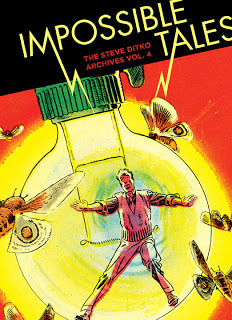 It's Mr. Steve Ditko's 85th birthday today! Amazing that the man continues to produce work (now approaching Issue #18 of his new series that's been coming out regularly since 2008). Yes, he's up to eighteen x 32 pages of story and art in the last four years. How many self-published/independent creators half Ditko's age have produced that much in the same time frame? Not many, I suspect.
It's Mr. Steve Ditko's 85th birthday today! Amazing that the man continues to produce work (now approaching Issue #18 of his new series that's been coming out regularly since 2008). Yes, he's up to eighteen x 32 pages of story and art in the last four years. How many self-published/independent creators half Ditko's age have produced that much in the same time frame? Not many, I suspect.Tom Spurgeon's Comics Reporter blog has a "Five for Friday" featuring Ditko, where you submit your five favourite Ditko issues. Artist Michel Fiffe has a nice, long piece on his Ditko Connection. And here's a whack of Steve Ditko images to get you in the celebratory mood.
'Round here, we're only up to 1958, compiling the first five years of his almost 60-year career in putting together comic books.
And 1958 is where you'll find us in Impossible Tales: The Steve Ditko Archives Vol. 4, coming out next May from Fantagraphics Books, Inc.
I'm scanning like a Mad Man this weekend for the upcoming volume; a great way to spend Steve's birthday immersed in all this fabulous artwork from one of the definite peaks of his career. Here's the publisher's blurb for the volume:
"Five years before Steve Ditko began work on his now legendary co-creations for Marvel Comics, the Amazing Spider-Man and Doctor Strange, he was producing some of his best work in near anonymity for Charlton Comics. Like its predecessors, Impossible Tales: The Steve Ditko Archives Vol. 4 features over 200 meticulously restored full-color pages of Ditko in his early prime - stories that have never seen a proper reprinting until now, thrilling stories of suspense, mystery, haunted houses, and unsuspecting victims all delineated in Ditko’s wildly idiosyncratic, masterful style. This fourth volume ranks as the best in the Archives series to date thanks in large part to the inspiration Ditko took from comics derived from the classic host-narrated radio shows, which gave an extra oomph to his creepy yarns. Moreover, comics such as This Magazine is Haunted and Tales of The Mysterious Traveler bore witness to a veritable explosion in Ditko’s ingenuity in terms of manipulating the traditional comic-book page layout. This new level of excellence also manifested itself in his work on other books, such Mysteries of Unexplored Worlds, Out of This World, Strange Suspense Stories, and Unusual Tales, all of which are amply represented in this volume."
Published on November 02, 2012 18:52
October 20, 2012
More Secrets from the History of Marvel Comics
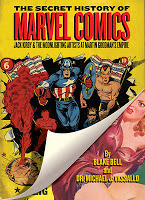 We're rushing to the end of the production cycle of the Secret History of Marvel Comics, from myself and noted 1930s-50s historian Dr. Michael J. Vassallo, published by Fantagraphics Books, Inc.
We're rushing to the end of the production cycle of the Secret History of Marvel Comics, from myself and noted 1930s-50s historian Dr. Michael J. Vassallo, published by Fantagraphics Books, Inc.Today, I'm adding to the captions list because, even after we submitted the design mock-up for the book back in late August, we're still coming up with potential new additions to our 300-page tome.
The book's all about the earliest days of Marvel Comics owner Martin Goodman and the Golden Age Marvel artists like Jack Kirby et al. who crossed over to do work in Goodman's other businesses. Since we thought we had closed the book on the design, we've uncovered two new pictures of Martin Goodman from the 1950s that are buried in his magazine line, including a nifty one with Charlton Heston from 1953.
This picture would have been taken just right after Heston's breakthrough role in The Greatest Show on Earth that won the Oscar for best picture of 1952. It was also three years before Heston played Moses in The Ten Commandments and six before he played Ben-Hur and won the Oscar for best actor. But, there he is, sitting with Goodman at Gogi La Rue's in New York City. The other picture has Goodman on a horse wearing a cowboy hat!
Our book won't make the Christmas rush, but that's what you get when you expand the scope of a book from 168 pages to 300! And we're still getting more artwork and Goodman magazines in that we never knew existed. (Finally nailed a copy of that Zippy mag with the Joe Simon cover, plus an Elvis magazine cover from 1957!) Just how many titles did that man produce? And you thought he flooded the market with his comics?
Published on October 20, 2012 09:38
October 19, 2012
America's Gayest Gagmen
Published on October 19, 2012 20:51
October 6, 2012
Sailor Jack Kirby
Fine tatooing. #Zippy #SecretHistoryOfMarvelComicsComingSoon
Published on October 06, 2012 16:47
Blake Bell's Blog
- Blake Bell's profile
- 7 followers
Blake Bell isn't a Goodreads Author
(yet),
but they
do have a blog,
so here are some recent posts imported from
their feed.




